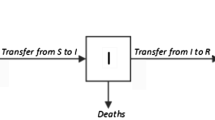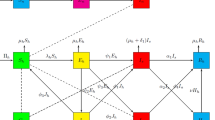Abstract
In this paper, we investigate the threshold dynamics of a dengue epidemic mathematical model with vaccination, standard incidence and incubation delays. We obtain the expression of the basic reproduction number. The local asymptotic stability of the disease-free equilibrium is studied by analyzing the distribution of roots of the corresponding characteristic equation. We determine the condition that model undergoes backward bifurcation by using the theory of centre manifold. By constructing suitable Lyapunov functional and using LaSalle’s invariance principle, the global stability of the endemic equilibrium in the case of zero mortality from disease is proved. In addition, we fit the cumulative weekly deaths reported in the earlier stage of the dengue outbreak in Brazil in 2019. Elasticity analysis is carried out to show the effects of vaccine-related parameters on the basic reproduction number. Furthermore, we use the Pontryagin’s minimum principle with delay to determine the optimal control strategies for dengue transmission.









Similar content being viewed by others
References
World Health Organization: Dengue and severe dengue. https://www.who.int/en/news-room/fact-sheets/detail/dengue-and-severe-dengue. Accessed 28 Jan 2022
Feng, Z., Velasco-Hernández, J.X.: Competitive exclusion in a vector-host model for the dengue fever. J. Math. Biol. 35, 523–544 (1997)
Esteva, L., Vargas, C.: Coexistence of different serotypes of dengue virus. J. Math. Biol. 46, 31–47 (2003)
Pongsumpun, P., Tang, I.M.: Transmission of dengue hemorrhagic fever in an age structured population. Math. Comput. Model. 37, 949–961 (2003)
Ma, Z., Zhou, Y., Wang, W., Jin, Z.: Mathematical Models and Dynamics of Infectious Diseases. Sciences Press, Beijing (2004)
Yang, H.M., Ferreira, C.P.: Assessing the effects of vector control on dengue transmission. Appl. Math. Comput. 198, 401–413 (2008)
Cai, L., Guo, S., Li, X., Ghosh, M.: Global dynamics of a dengue epidemic mathematical model. Chaos, Solitons Fractals 42, 2297–2304 (2009)
Esteva, L., Vargas, C.: Analysis of a dengue disease transmission model. Math. Biosci. 150, 131–151 (1998)
Hethcote, H.W.: The mathematics of infectious diseases. SIAM Rev. 42, 599–653 (2000)
Esteva, L., Vargas, C.: A model for dengue disease with variable human population. J. Math. Biol. 38, 220–240 (1999)
Derouich, M., Boutayeb, A.: Dengue fever: mathematical modelling and computer simulation. Appl. Math. Comput. 177, 528–544 (2006)
Garba, S.M., Gumel, A.B., Abu Bakar, M.R.: Backward bifurcations in dengue transmission dynamics. Math. Biosci. 215, 11–25 (2008)
Favier, C., Degallier, N., Rosa-Freitas, M.G., et al.: Early determination of the reproductive number for vector-borne diseases: the case of dengue in Brazil. Trop Med Int Health 11, 332–340 (2006)
Chan, M., Johansson, M.A.: The incubation periods of dengue viruses. PLoS One 7, e50972 (2012)
Sakdanupaph, W., Moore, E.J.: A delay differential equation model for dengue fever transmission in selected countries of South-East Asia. In: AIP Conference Proceedings, vol. 1148, pp. 816–819. American Institute of Physics (2009)
Wu, C., Wong, P.J.Y.: Dengue transmission: mathematical model with discrete time delays and estimation of the reproduction number. J. Biol. Dyn. 13, 1–25 (2019)
Aguiar, M., Stollenwerk, N., Halstead, S.B.: The impact of the newly licensed dengue vaccine in endemic countries. PLoS Negl. Trop. Dis. 10, e0005179 (2016)
Xiang, J., Wang, J., Cai, L.: Global stability of the dengue disease transmission models. Discrete Contin. Dyn. Syst.-B 20, 2217–2232 (2015)
Chanprasopchai, P., Tang, I., Pongsumpun, P.: SIR model for dengue disease with effect of dengue vaccination. Comput. Math. Methods Med. 2018, 14 (2018)
Hale, J.K., Verduyn Lunel, S.: Introduction to Functional Differential Equations. Springer, New York (1993)
Zhao, X.: Basic reproduction ratios for periodic compartmental models with time delay. J. Dyn. Differ. Equ. 29, 67–82 (2017)
Castillo-Chavez, C., Song, B.: Dynamical model of tuberclosis and their applications. Math. Biosci. Eng. 1, 361–404 (2004)
Paez, T.L.: Introduction to model validation. In: Proceedings of the IMAC-XXVII, pp. 1–11. Society for Experimental Mechanics, USA (2008)
Pan American Health Organization. Dengue cases. https://www3.paho.org/data/index.php/en/mnu-topics/indicadores-dengue-en/dengue-nacional-en/252-dengue-pais-ano-en.html. Accessed 16 Mar 2022
Sanofi. Dengue immunization public program in paraná state of Brazil set to achieve WHO 2020 ambition. https://www.sanofi.com/en/media-room/press-releases/2016/2016-08-13-13-00-00. Accessed 5 Apr 2022
World Health Organization. Global health estimates: life expectancy and leading causes of death and disability. https://www.who.int/data/gho/data/themes/mortality-and-global-health-estimates. Accessed 27 Feb 2022
Martcheva, M.: An Introduction to Mathematical Epidemilogy. Springer, New York (2015)
United Nations Statistics Division. Demographic and social statistics. https://unstats.un.org/unsd/demographic-social/products/vitstats/index.cshtml. Accessed 27 Feb 2022
Centers for Disease Control and Prevention. Dengue Vaccine. https://www.cdc.gov/dengue/vaccine/hcp/safety-efficacy.html. Accessed 14 Mar 2022
Andraud, M., Hens, N., Marais, C., et al.: Dynamic epidemiological models for dengue transmission: a systematic review of structural approaches. PLoS One 7, e49085 (2012)
Göllmann, L., Kern, D., Maurer, H.: Optimal control problems with delays in state and control variables subject to mixed control-state constraints. Opt. Control Appl. Methods 30, 341–365 (2009)
Fleming, W.H., Rishel, R.W.: Deterministic and Stochastic Optimal Control. Springer, New York (1975)
Laarabi, H., Abta, A., Hattaf, K.: Optimal control of a delayed SIRS epidemic model with vaccination and treatment. Acta. Biotheor. 63, 87–97 (2015)
Acknowledgements
This work was supported by the National Natural Science Foundation of China (Nos. 11871316, 11801340).
Author information
Authors and Affiliations
Corresponding author
Ethics declarations
Conflict of interest
The authors have no conflicts of interest in this paper.
Additional information
Publisher's Note
Springer Nature remains neutral with regard to jurisdictional claims in published maps and institutional affiliations.
Rights and permissions
Springer Nature or its licensor holds exclusive rights to this article under a publishing agreement with the author(s) or other rightsholder(s); author self-archiving of the accepted manuscript version of this article is solely governed by the terms of such publishing agreement and applicable law.
Springer Nature or its licensor holds exclusive rights to this article under a publishing agreement with the author(s) or other rightsholder(s); author self-archiving of the accepted manuscript version of this article is solely governed by the terms of such publishing agreement and applicable law.
About this article
Cite this article
Ren, J., Xu, R. Dynamic analysis and application of a dengue transmission model with vaccination and incubation delays. J. Appl. Math. Comput. 69, 895–920 (2023). https://doi.org/10.1007/s12190-022-01776-1
Received:
Revised:
Accepted:
Published:
Issue Date:
DOI: https://doi.org/10.1007/s12190-022-01776-1




